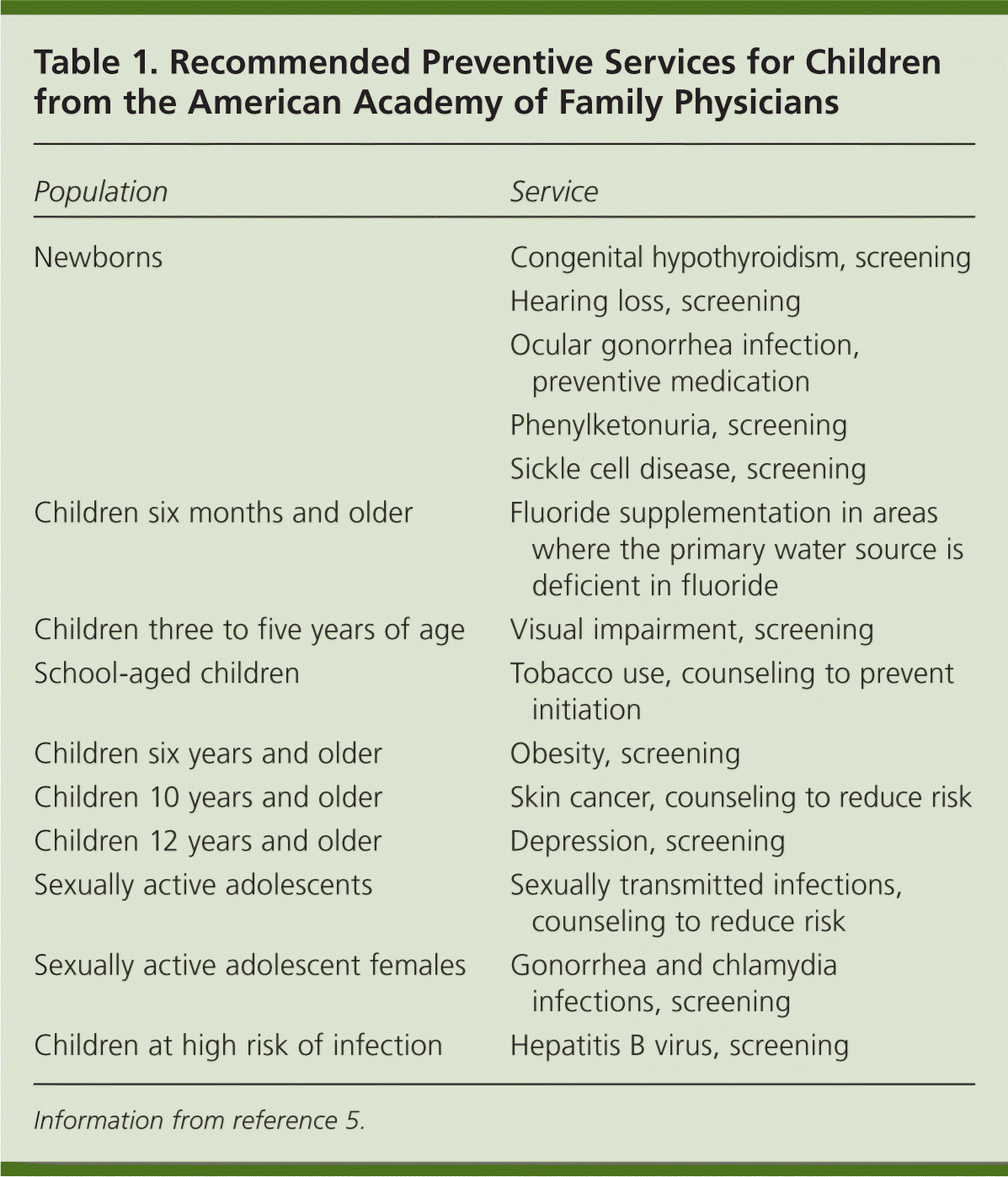
Am Fam Physician. 2015;91(6):362-364
More than two-thirds of practicing family physicians report that they provide care for children,1 and well-child visits provide the best opportunities to deliver evidence-based preventive services. These services include administering immunizations, assessing growth and development, and counseling children and parents about behavioral issues, nutrition, exercise, and prevention of unintentional injury.2
The American Academy of Pediatrics (AAP) recently updated its recommendations on preventive health care for children,3 which define a set of services that, under the Affordable Care Act, must be covered by Medicaid and private insurers at no out-of-pocket cost.4 The current AAP Bright Futures guideline (available at http://www.aap.org/en-us/professional-resources/practice-support/Periodicity/Periodicity%20Schedule_FINAL.pdf) includes three screening tests that were not recommended for all children in previous versions: autism screening at 18 and 24 months of age, cholesterol screening between nine and 11 years of age, and annual screening for high blood pressure beginning at three years of age.
It should be noted that none of these screening tests are included in the American Academy of Family Physicians' (AAFP's) list of recommended preventive services for children (Table 1).5 The AAFP's clinical preventive services recommendations are generally consistent with those of the U.S. Preventive Services Task Force (USPSTF). The USPSTF methods for developing recommendations include performing a systematic evidence review of the benefits and harms of a preventive service, and recommending that the service be provided to the general population only after consistent data from high-quality randomized controlled trials or other prospective studies establish that the benefits exceed the harms.6 This rigorous approach to the development of clinical practice guidelines has been endorsed by the Institute of Medicine.7 In contrast, few AAP policy statements on well-child care are supported by direct evidence of net health benefit.8,9

| Population | Service |
|---|---|
| Newborns | Congenital hypothyroidism, screening |
| Hearing loss, screening | |
| Ocular gonorrhea infection, preventive medication | |
| Phenylketonuria, screening | |
| Sickle cell disease, screening | |
| Children six months and older | Fluoride supplementation in areas where the primary water source is deficient in fluoride |
| Children three to five years of age | Visual impairment, screening |
| School-aged children | Tobacco use, counseling to prevent initiation |
| Children six years and older | Obesity, screening |
| Children 10 years and older | Skin cancer, counseling to reduce risk |
| Children 12 years and older | Depression, screening |
| Sexually active adolescents | Sexually transmitted infections, counseling to reduce risk |
| Sexually active adolescent females | Gonorrhea and chlamydia infections, screening |
| Children at high risk of infection | Hepatitis B virus, screening |
The rationale for the AAP's recommendation to routinely screen toddlers for autism spectrum disorders (ASDs) with ASD-specific screening tools is to advance the time of diagnosis and deliver early interventions.10 Although a systematic review of 40 studies found that a policy of universal screening for ASD increased rates of diagnosis and referral, the effects of such policies on time of diagnosis or enrollment in services are unclear.11 The entire body of evidence that intensive behavioral interventions improve language skills and cognitive or functional outcomes in children with ASD consists of a single randomized controlled trial and several prospective cohort studies of varying quality.12,13
The AAP recommends measurement of blood pressure and cholesterol levels in children to identify modifiable risk factors for cardiovascular disease and to provide early interventions to reduce future risk. However, no studies have evaluated whether treating primary hypertension in persons younger than 18 years reduces adverse cardiovascular outcomes in adulthood.14,15 Similarly, evidence is lacking that lowering cholesterol levels with lifestyle changes or medications improves cardiovascular outcomes, and long-term statin use is associated with rare but serious harms.16,17
Time is a precious clinical resource. Clinicians who spend time delivering unproven or ineffective interventions at health maintenance visits risk “crowding out” effective services. For example, a national survey of family and internal medicine physicians regarding adult well-male examination practices found that physicians spent an average of five minutes discussing prostate-specific antigen screening (a service that the AAFP and the USPSTF recommend against because the harms outweigh the benefits18), but one minute or less each on nutrition and smoking cessation counseling.19 Similarly, family physicians have limited time at well-child visits and therefore should prioritize preventive services that have strong evidence of net benefit.
editor's note: Dr. Lin is associate deputy editor of AFP Online and chair of the Subcommittee on Clinical Practice Guidelines of the AAFP's Commission on the Health of the Public and Science. Because of Dr. Lin's dual roles, two other medical editors independently reviewed this editorial for publication.
